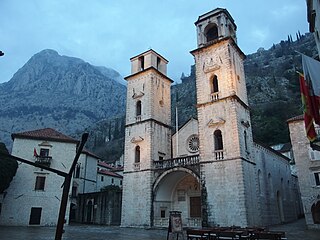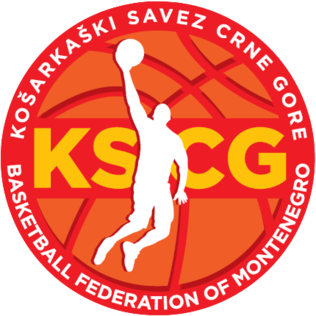
Montenegro is a country in Southeastern Europe, on the Balkan Peninsula. Its 25 municipalities have a total population of 633,158 people in an area of 13,812 km2. It is bordered by Bosnia and Herzegovina to the northwest, Serbia to the northeast, Kosovo to the east, Albania to the southeast, Croatia to the west, and has a coastline along the Adriatic Sea to the southwest. The capital and largest city is Podgorica, while Cetinje is the Old Royal Capital and cultural centre.

Cetinje is a town in Montenegro. It is the former royal capital of Montenegro and is the location of several national institutions, including the official residence of the president of Montenegro. According to the 2023 census, the town had a population of 12,460 while the Cetinje Municipality had 14,465 residents. Cetinje is the centre of Cetinje Municipality. The city rests on a small karst plain surrounded by limestone mountains, including Mount Lovćen, the legendary mountain in Montenegrin historiography. Cetinje was founded in the 15th century and became a cradle of the culture of Montenegro. Its status as the honorary capital of Montenegro is due to its heritage as a long-serving former capital of Montenegro.

The national flag of Montenegro has a red field with gold border and the coat of arms of Montenegro in its center. It was officially adopted on 13 July 2004, when the then Republic of Montenegro was a constituent of the State Union of Serbia and Montenegro, and its precise specification was standardized on 16 September 2004. The flag was retained after Montenegrin independence from Serbia in 2006, and mandated by Article 4 of the Constitution of Montenegro adopted in 2007.
The Democratic Party of Socialists of Montenegro is a social-democratic and populist political party in Montenegro. A former long-time ruling party sitting at the opposition for the first time since 2020, it was formed on 22 June 1991 as the successor of the League of Communists of Montenegro, which had governed Montenegro within the Socialist Federal Republic of Yugoslavia since World War II, and has remained a major force in the country ever since. The party is a member of the Socialist International and the Progressive Alliance, and an associate of the Party of European Socialists. During the 1990s, DPS was the major centre-left, social-democratic party in favour of Serbian–Montenegrin unionism. However, since 1997, the party has embraced Montenegrin independence and has been improving ties with the West, slowly turning into a catch-all party embracing Atlanticism, Montenegrin nationalism, neoliberalism, and pro-Europeanism.

Montenegrins are a South Slavic ethnic group that share a common ancestry, culture, history, and language, identified with the country of Montenegro.
The demographic history of Montenegro can be shown through census results and official documents which mention demographic composition.
Montenegrin is a normative variety of the Serbo-Croatian language mainly used by Montenegrins and is the official language of Montenegro. Montenegrin is based on the most widespread dialect of Serbo-Croatian, Shtokavian, more specifically on Eastern Herzegovinian, which is also the basis of Standard Croatian, Serbian, and Bosnian.

Demographic features of the population of Montenegro include population density, ethnicity, education level, health of the populace, economic status, religious affiliations and other aspects.

Montenegro has participated in the Eurovision Song Contest 12 times since its debut in 2007. The Montenegrin participant broadcaster in the contest is Radio i Televizija Crne Gore (RTCG).

Islam in Montenegro refers to adherents, communities and religious institutions of Islam in Montenegro. It is the second largest religion in the country, after Christianity. According to the 2011 census, Montenegro's 118,477 Muslims make up 20% of the total population. Montenegro's Muslims belong mostly to the Sunni branch. According to the estimate by the Pew Research Center, Muslims have a population of 130,000 (20.3%) as of 2020.

The culture of Montenegro is as pluralistic and diverse as its history and geographical position would suggest. Montenegro's culture has been influenced by the Serbian Empire, the Byzantine Empire, ancient Greece, ancient Rome, Christianity, the Ottoman Empire, the Republic of Venice, Austria-Hungary, and Yugoslavia.
Sport in Montenegro revolves mostly around team sports, such as football, basketball, handball, and volleyball. Other sports involved are boxing, tennis, swimming, judo, karate, athletics, table tennis, and chess.

Eastern Orthodox Christianity is the largest religion in Montenegro at 71% of the population, and is the religion of choice for the vast majority of ethnic Montenegrins and Serbs. In addition to Eastern Orthodox Christianity, there is also a sizeable number of adherents to Sunni Islam at 20% of the population, mainly from ethnic Bosniaks and Albanians.

The Montenegro men's national basketball team represents Montenegro in international basketball tournaments. The supervising body is the Basketball Federation of Montenegro.

Citizenship of Montenegro is the citizenship of Montenegro. It is regulated by a citizenship law, ratified by Parliament in 2008 and published by the Official Journal of Montenegro. It is mainly based on jus sanguinis. There are also provisions for citizenship-by-investment, though the government has suspended the relevant guidelines in the face of European Union concern.

Turks in Montenegro, also known as Turkish Montenegrins and Montenegrin Turks, are ethnic Turks who form an ethnic minority in Montenegro.
The Montenegro women's national basketball team represents Montenegro in international women's basketball tournaments. The supervising body is the Basketball Federation of Montenegro.
The Montenegrin women's national team entered international competition in 2008, playing their first official match on 27 August, against Republic of Ireland in Bijelo Polje (68–56).
The Montenegrin women's team participated at the EuroBasket Women four times – 2011, 2013, 2015, and 2017 reaching the quarterfinals twice.
The Montenegrin Women's Football league or 1. ŽFL is the top level women's football league of Montenegro. It is organized by the Football Association of Montenegro.

Montenegro–Turkey relations are the bilateral relations between Montenegro and Turkey. Turkey officially recognized Montenegro on June 12, 2006. Diplomatic relations between the two countries were established on July 3, 2006. Both countries are full members of the Union for the Mediterranean, Council of Europe and NATO. And Montenegro is with Slovenia is Sectoral dialogue partner countries of Organization of the Black Sea Economic Cooperation.

Serbs of Montenegro or Montenegrin Serbs, compose native and the second largest ethnic group in Montenegro, after the ethnic Montenegrins. Additional 0.47% of the population is made up of Serbs-Montenegrins and Montenegrins-Serbs.













